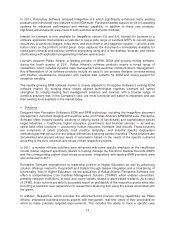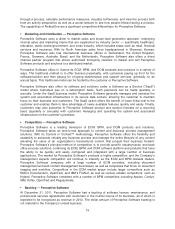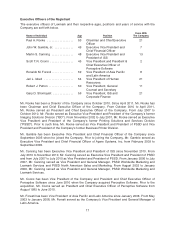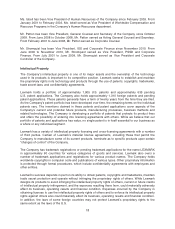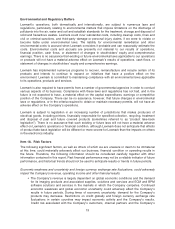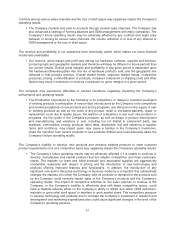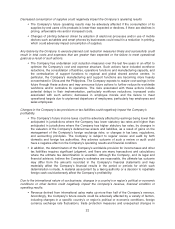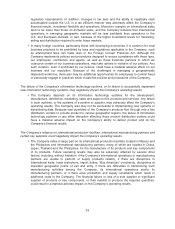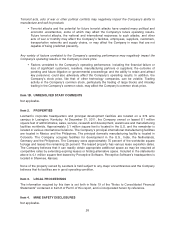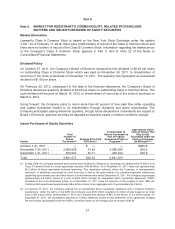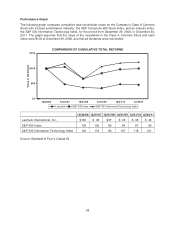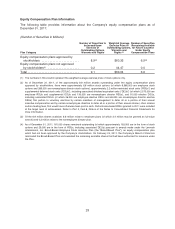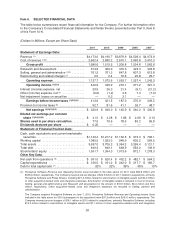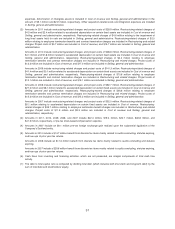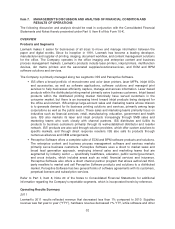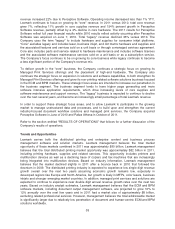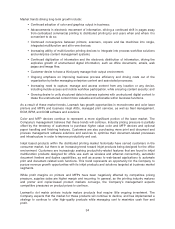Lexmark 2011 Annual Report Download - page 28
Download and view the complete annual report
Please find page 28 of the 2011 Lexmark annual report below. You can navigate through the pages in the report by either clicking on the pages listed below, or by using the keyword search tool below to find specific information within the annual report.Business disruptions could seriously harm our future revenue and financial condition and increase our
costs and expenses.
• Our worldwide operations and those of our manufacturing partners, suppliers, and freight
transporters, among others, are subject to natural and manmade disasters and other business
interruptions such as earthquakes, tsunamis, floods, hurricanes, typhoons, fires, extreme weather
conditions, environmental hazards, power shortages, water shortages and telecommunications
failures. As evidenced by the flooding in Thailand, which has resulted in increased manufacturing
costs, the occurrence of any of these business disruptions could seriously harm our revenue and
financial condition and increase our costs and expenses. As the Company continues its
consolidation of certain functions into shared service centers and movement of certain functions
to lower cost countries, the probability and impact of business disruptions may be increased over
time.
The entrance of additional competitors that are focused on printing solutions and software solutions,
including ECM and BPM solutions, could negatively impact the Company’s strategy and operating results.
• The entrance of additional competitors that are focused on printing solutions could further
intensify competition in the inkjet and laser printer markets and could have a material adverse
impact on the Company’s strategy and financial results.
• The Company acquired Perceptive Software in 2010 and Pallas Athena in 2011 to strengthen its
industry workflow solutions and to compete in the ECM and BPM and document-process
automation software solutions market and the entrance of additional competitors that are focused
on ECM and BPM solutions could materially impact the Company’s strategy to expand in this
market and adversely affect the Company’s financial results.
The Company may fail to realize all of the anticipated benefits of any investments, acquisitions or other
significant transactions, which could harm our financial results.
• As part of our business strategy, the Company routinely discusses, evaluates opportunities, and
may enter into agreements regarding possible investments, acquisitions, and other transactions.
Such transactions, including our acquisitions of Perceptive Software and Pallas Athena, routinely
involve significant risks and challenges and the Company may not be able to realize all of the
anticipated benefits of such transactions. The Company may not be able to identify suitable
opportunities on terms acceptable to the Company. The transaction may fail to advance the
Company’s business strategy. The Company may not realize a satisfactory return on our
investment. The Company may not be able to obtain regulatory or other approvals required for
the transaction. The future business operations of an acquired entity may not be successful. The
Company may not be able to retain customers and key employees of an acquired entity. The
Company may not be able to realize expense synergies and revenue expansion goals.
Disruptions from the transaction could harm relationships with the Company’s or the acquired
entity’s existing customers, business partners, employees and suppliers. The Company may face
a difficult time integrating new employees, business systems and technology. Intangible assets
and goodwill recognized by the Company in the acquisition could become impaired if subsequent
measurements of fair value and implied value, respectively, do not support the carrying values of
such assets.
The Company’s inability to perform satisfactorily under service contracts for managed print services may
negatively impact the Company’s strategy and operating results.
• The Company’s inability to perform satisfactorily under service contracts for managed print
services and other customer services may result in the loss of customers, loss of reputation and/
or financial consequences that may have a material adverse impact on the Company’s financial
results and strategy.
24


